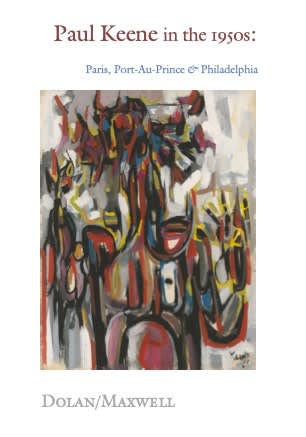We are pleased to share this distinguished body of work from a pivotal chapter in the career of Paul Keene. Selections here trace his artistic evolution through formative years spent in Paris (1949–1951), Haiti (1951–1954), and subsequent developments in his practice after his return to Philadelphia. Paul was a Philadelphia native and World War II veteran who served as a navigator with the Tuskegee Airmen. In the early 1940s, he studied at the Pennsylvania Museum and School of Industrial Art (later University of the Arts); and, after WWII, at Temple University’s Tyler School of Art with support from the G.I. Bill. He had already begun exhibiting locally and engaging with Philadelphia’s vibrant Black cultural scene—most notably the Pyramid Club— where his early works reflected Social Realism, jazz culture, and the energy of North Philadelphia street life. In 1949, after being denied a university teaching position due to racial discrimination, Keene and his bride, Laura Mitchell Keene, relocated to Paris, where Paul enrolled at the Académie Julian. Immersed in the postwar art world of Paris, he studied African sculpture at the Musée de l’Homme, visited the studios of Picasso and Léger, and exhibited in the major Paris Salons. He was a co-founder of Galerie Huit, a pioneering collective of American artists abroad. As with many African American artists, Paris offered an atmosphere of creative freedom and racial respite, opening new paths for artistic inquiry. A John Hay Whitney Fellowship brought Keene to Haiti in 1952, where he sought and found a deep resonance between West African traditions and Haitian cultural expression. While in Haiti, his work became more symbolically charged and formally experimental, drawing on Haitian music, religion, and landscape. Moving fluidly between figuration and abstraction, Keene explored rhythm, narrative, and spirituality, forging a visual language rooted in the African diasporic experience. Our publication coincides with Keene's inclusion in a new exhibition at the Centre Pompidou, “Paris Noir offers a vibrant immersion in a cosmopolitan Paris, a place of resistance and creation that gave rise to a wide variety of practices, from a new awareness of identity to the search for trans-cultural artistic languages. From international to Afro-Atlantic abstractions via Surrealism and free figuration, this historical voyage reveals the importance of artists of African descent in the redefinition of Modernisms and Post-modernisms.” The Pompidou Centre’s thesis perfectly suits Keene’s experience among global networks of artists who found in postwar Paris a place of radical possibility.-modernisms.” The Pompidou Centre’s thesis perfectly suits Keene’s experience among global networks of artists who found in postwar Paris a place of radical possibility.


